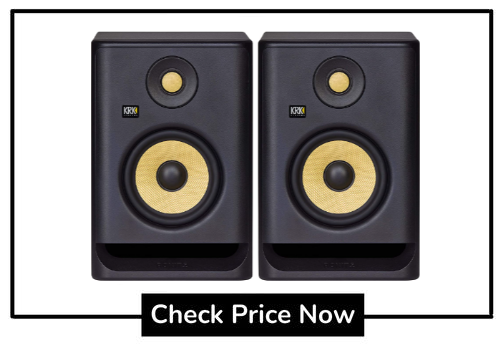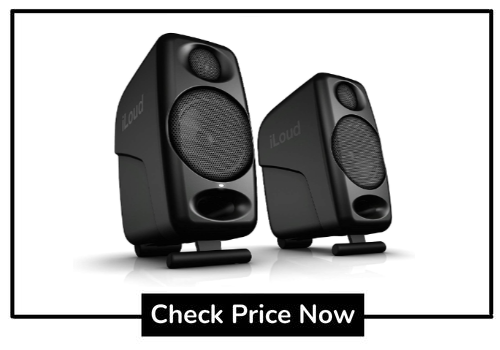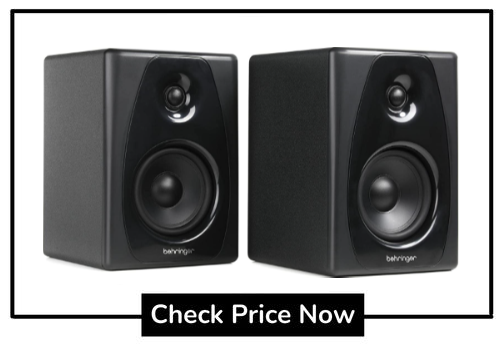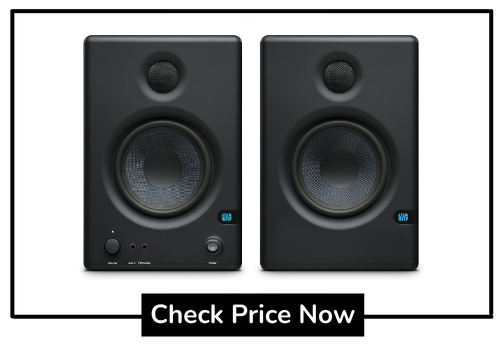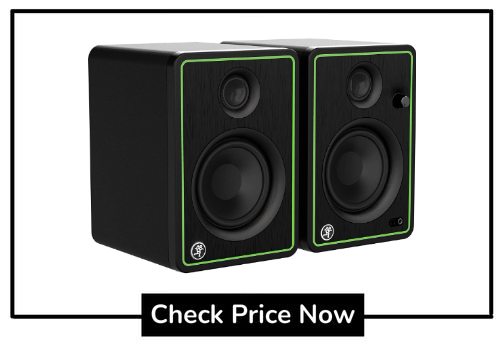If you’re a digital piano enthusiast, then you probably already know that a good pair of studio monitors can greatly improve your playing experience.
However, finding the right pair of monitors for your needs isn’t always easy. In this blog post, we’ll take a look at some of the best studio monitors for digital piano, so keep reading to learn more!
When selecting the best studio monitors for digital piano, it is important to consider the type of studio monitor you need.
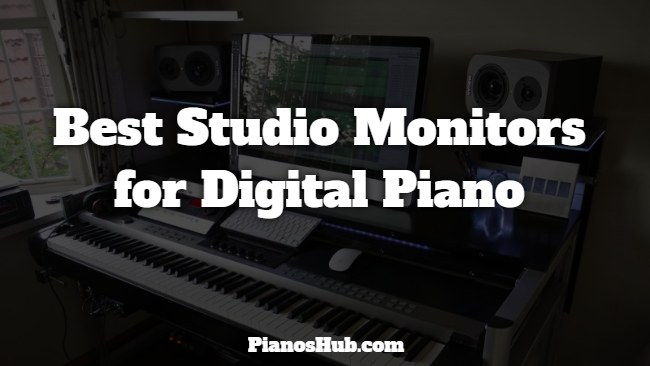
There are different types of studio monitors available, such as active and passive monitors, near-field and far-field monitors, and powered and unpowered monitors.
How to know what is the best studio monitors for digital piano among them? If you are also confused, don’t worry. We’re here to help find the best one.
Best Studio Monitors for Digital Piano
When selecting the best studio monitors for digital piano, it is important to consider the type of studio monitor you need. There are different types of studio monitors available, and finding the best studio monitors for digital piano may be difficult. That’s why we have listed the top 5 best studio monitors for digital piano here.
KRK RP5 Rokit 5 G4 Professional Bi-Amp 5″ Powered Studio Monitor
The KRK RP5 is a powered studio monitor that has 5 (bi-amp) speakers. It has proprietary speaker drivers that are built in-house from the ground up. It is built in the US and comes with a built-in Class D power amp. The speakers have onboard LCD visual ds-driven EQ. It also has a built-in efficient Class D power amp. The speakers deliver clear and accurate sound.
The speakers are able to deliver high-quality sound that is suitable for mixing and mastering. The KRK RP5 is a five-driver studio monitor with an excellent build and bass response that’s only limited by the kinds of listening environments you’ll be using it in. It may not have the best sound quality overall, but it’s especially effective at reproducing bass, which gave it an edge over some more upscale models in this price range.
And the RP5’s visual EQ controls are customizable, so you can make the speaker sound the way you want it to, even if that means sacrificing a little clarity or detail. You can also match your monitor’s sound to your room using a simple onscreen reference. There are certainly cheaper and better-sounding monitors in this price range, and the RP5 can’t match the accuracy of sound that you’ll get from a pair of studio monitors costing twice as much.
However, its build quality is excellent, it’s ideal for home setups, and the controls are easy to understand and use. Plus, the KRK RP5’s bass accuracy renders it suitable as an alternative to active subwoofers for low frequencies, and its ability to reproduce sound from a reduced distance makes it a good choice for small rooms.
IK Multimedia iLoud Micro Monitor Dual Speakers
The IK Multimedia iLoud Micro Monitor 50-watt Portable Wireless Bluetooth Studio Reference Monitors are as close to studio monitors as you can get without dropping $2,000. Their frequency response is flat and true, and the quality is what you’d expect from monitors costing twice as much. They sound as good or better than your earbuds or in your car.
The iLoud Micro Monitors are wireless, making them perfect for musicians and music producers who work on their computers. They are highly portable, and you can use them in a variety of different listening environments. They are capable of reproducing the full range of frequencies.
They deliver smooth and extended high frequencies, an exceptionally open, focused midrange, and a solid, controlled low end. IK Multimedia iLoud Micro Monitor – Bluetooth Speaker System is a reliable compact speaker that delivers great sound, portability, and versatility.
The controls are easy to understand and use, and the included travel bag makes it easy to pack them in your carry-on. The only drawback is their short battery life (a few hours at most), but at $200.99 a pair, it’s easy to pick up an extra battery and then just plug them in while you’re driving.
Behringer Studio 50USB 5 Inches Powered Studio Monitors
Behringer Studio 50USB powered studio monitors with USB connection are designed to provide great sound for musicians, podcasters, and home recording enthusiasts. These 5-inch powered studio monitors feature 150 watts of peak power and feature a 1-inch silk soft-dome tweeter and a 5-inch polypropylene woofer. The Studio 50USB can be used for mixing, recording, and mastering.
The Studio 50USB also comes with both XLR and TRS connectors. These monitors offer a wide frequency range from 45 Hz to 20 kHz. They feature a 5/8-inch unbalanced TRS input jack and a 1/8-inch unbalanced TRS headphone output. These two Behringer Studio 50USB powered studio monitors with USB connection are an excellent addition to any music studio, podcast studio, or home recording studio.
These Behringer Studio 50USB powered monitors are a solid option for a budget-friendly USB-powered studio speaker. They deliver accurate sound across the board, from warm lows to crisp highs, and they perform adequately in our video-conferencing tests.
They also come equipped with a USB audio interface and Behringer’s Music Maker 2 Music Creation Software and Softube Time and Tone Bundle to help get you started with your home studio. The Studio 50USBs offer good bang for your buck, but they lack a few features that the better-priced Studio 51USB models offer.
PreSonus Eris E4.5-2-Way 4.5″ Near Field Studio Monitor
The Eris E4.5 is a two-way, near-field monitor that is capable of providing you with studio-quality sound. It comes with a 4.5-inch woven-composite low-frequency transducer, a 1-inch ultra-low-mass silk-dome high-frequency transducer, and a 50-watt Class AB amplifier.
The low-frequency transducer produces a well-balanced and accurate sound. The high-frequency transducer eliminates harshness and ensures that your audio sounds natural. The frequency response of these monitors is 30Hz to 20kHz, and the dynamic range is 100dB.
The Eris E4.5 features an adjustable low-frequency and high-frequency control. This allows you to adjust the frequency response according to the space you’re in. It also features a stereo auxiliary input. This allows you to connect your portable device such as a smartphone.
The Eris E4.5 comes with a headphone jack for private listening. It also includes volume and power on/off buttons on the front panel for easy access. The Eris E4.5 features a rear-firing, round bass-reflex port. Overall, this is one of the best studio monitors for digital piano.
Mackie CR-X Series, 4-Inch Multimedia Monitors
The Mackie CR-X Series is a 4-inch multimedia monitor with professional studio-quality sound. It features a front-facing headphone jack that automatically disables the speaker output. This monitor also features a flexible input system that allows you to connect the monitor to an RCA or 1/4-inch jack.
This monitor has 50 watts of clean, articulate stereo sound. This monitor also has a built-in, class-compliant USB audio interface that allows you to connect a compatible audio interface or DAW.
Mackie’s CR4-X series monitors are one of the best monitors for mixing music. They sound great, and at $240 a pair, they’re also one of the cheapest monitors with comparable sound quality.
If you’re getting into mixing music, you won’t find much wrong with this set unless you’re an advanced user looking for serious metering. Beyond that, the CR4-X monitors are a great buy.
How To Choose the Best Studio Monitors for Digital Piano
When selecting the best studio monitors for digital piano, it is important to consider the type of studio monitor you need. There are different types of studio monitors available, such as active and passive monitors, near-field and far-field monitors, and powered and unpowered monitors.
Active monitors have powered speakers that include an onboard amplifier. Passive monitors require an external amplifier, while near-field monitors are designed for close listening and far-field monitors are designed for larger spaces. Powered monitors are pre-amplified, while unpowered monitors need to be plugged into an external amplifier to increase the volume.
In addition to size and type, the frequency range of the monitor is an important factor. Digital pianos usually range from 20 Hz to 20kHz, so it is important that the monitor can reproduce sound within this range. Low-frequency drivers are necessary for good bass response, while high-frequency drivers are used to reproducing the highest notes.
The crossover frequency is important, as it determines the frequencies sent to each driver. It is also important to consider the power rating of the monitors, as this will determine the volume of the sound produced also have a look on best stand for digital piano. Finally, it is important to consider the price of the monitors.
Active monitors tend to be more expensive than passive monitors, and powered monitors are usually more expensive than unpowered monitors. It is important to find a balance between price and quality, as the best studio monitors will produce the best sound. Researching different brands and models to find the best studio monitors for digital piano will help ensure that you get the best sound for your money.
What Should I Look When Finding the Best Studio Monitors for Digital Piano?
When it comes to finding the best studio monitors for digital piano, there are a few key things to consider. Firstly, you want to make sure that the monitors have a flat frequency response that accurately reproduces the sound of your digital piano. This means that you should be looking for monitors that have a frequency response range of between 30 Hz and 20 kHz.
Secondly, you want to make sure that they have enough power to adequately reproduce the signal from your digital piano. Ideally, you should be looking for monitors that have a power rating of at least 50W, although higher-end models may have up to 200W of power. Finally, it’s important to consider the size and shape of the studio monitors, as this will determine how they fit in your studio setup.
When it comes to the technical specifications of the monitors, you should be on the lookout for monitors that have a low total harmonic distortion rating. This will ensure that the sound coming from your monitors is as clear and accurate as possible.
Additionally, look for a high signal-to-noise ratio and a wide dynamic range, as this will help to ensure that your digital piano will sound its best when recorded or monitored through the monitors. Finally, make sure that the monitors come with adequate shielding from electromagnetic interference, as this will prevent any unwanted noise from entering your audio recordings.
Final Words
Ultimately, when looking for the best studio monitors for digital piano, it’s important to consider the size, power, and frequency response of the monitors, as well as their technical specifications such as the total harmonic distortion, the signal-to-noise ratio, and the dynamic range. Taking all of these factors into account will ensure that you get the best sound out of your digital piano, allowing you to recreate the perfect sound in your studio.
We hope this guide on the best studio monitors for digital piano helped you find a suitable monitor for your studio. If you have any questions related to this post, feel free to reach out to our Pianos Hub team. We will be happy to help.
